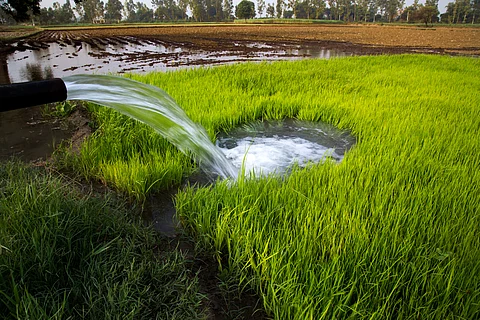

Arsenic contamination, long a concern in Bihar’s water supply, has now been detected at alarming levels in staple foods such as rice, wheat and potatoes, posing significant health risks to thousands, particularly in rural areas.
A study conducted by researchers from Patna-based Mahavir Cancer Sansthan and Research Centre has revealed high arsenic concentrations in these staple foods in 11 arsenic hotspot districts of Bihar. The findings underscored an urgent public health challenge as the food chain becomes increasingly contaminated.
“This is a matter of serious concern. After water, arsenic content in the food chain is rising,” said Arun Kumar, one of the lead scientists involved in the study.
The study analysed arsenic levels in rice samples collected from 369 households in arsenic-exposed areas. Of these, 319 households had arsenic levels below the permissible limit, while 50 households exceeded the limit.
The highest arsenic content in rice was recorded at 821 microgrammes per kilogramme (µg/kg). The Food and Agriculture Organization of the United Nations sets the permissible arsenic levels for rice, wheat and potatoes at 200 µg/kg, 100 µg/kg and 500 µg/kg, respectively.
Similarly, wheat samples were analysed from 279 households, with 105 households showing arsenic levels below permissible limits and 174 exceeding them. The highest arsenic content in wheat was 775 µg/kg.
Potato samples from 168 households were also tested. While 163 households had arsenic levels within permissible limits, five exceeded them, with the highest arsenic concentration reaching 1,450 µg/kg.
The study reported that 14 per cent of rice samples, 63 per cent of wheat samples and 3 per cent of potato samples contained arsenic levels above the FAO limits. The highest contamination levels in rice, wheat and potatoes were recorded as 821 µg/kg, 775 µg/kg and 1,450 µg/kg, respectively.
The study also highlighted significant arsenic contamination in groundwater, which is a key source of irrigation in these regions. Out of 513 groundwater samples taken from hand pumps, 450 were within the permissible limit of 10 µg/L, while the highest recorded arsenic level was 550.7 µg/L.
The study identified a direct link between arsenic-contaminated staple foods, such as rice, wheat and potato and elevated arsenic levels in human blood. The researchers noted that the arsenic biomagnification through the food chain was the first such finding reported in these 11 districts of Bihar.
“The excessive arsenic content in the blood of the population studied is due to the consumption of contaminated rice, wheat and potatoes,” Kumar explained. “This contamination is even reaching infants through breast milk, putting them at a very high risk.”
The study revealed that 55 per cent of exposed lactating mothers had arsenic concentrations in their breast milk exceeding WHO’s permissible limit. Furthermore, 65 per cent of infants tested had elevated arsenic levels in their urine, with only 50 per cent of the arsenic being expelled from their bodies.
The remaining arsenic was found to accumulate in vital organs such as the brain, liver and kidneys, potentially leading to severe health issues.
The findings challenge earlier studies suggesting that arsenic methylation during pregnancy and breastfeeding protects infants. The study warned that children consuming arsenic-laden breast milk are at risk of long-term health complications and urgently require medical intervention.
The study attributed the arsenic contamination to the sediment deposits in the Gangetic plains. The oscillation zone of the River Ganga, characterised by crests and troughs, has become a hotspot for arsenic deposits due to changes in the river’s morphology over the past 50 years.
This sedimentation process has resulted in higher contamination levels along the riverbanks compared to northern districts like Darbhanga and Champaran, the paper said.
The affected districts — Buxar, Bhojpur, Saran, Patna, Vaishali, Samastipur, Begusarai, Khagaria, Nalanda, Darbhanga and Munger — are at significant risk of a burgeoning disease burden. Infants and children are particularly vulnerable to arsenic poisoning, which can impair vital organs and cognitive development, the scientists warned.
The research also highlighted the role of irrigation with arsenic-contaminated water in exacerbating soil contamination, as shown by previous studies. Over time, this has led to increased arsenic retention in the soil, further magnifying the risk of biomagnification through the food chain.
Researchers called for immediate medical and policy interventions to address this crisis. Regular testing of groundwater and food products, along with awareness campaigns about arsenic exposure, are critical. Additionally, safer agricultural practices and alternative water sources for irrigation are essential to reduce arsenic levels in the food chain.